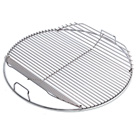There are two ways to grill: indirect grilling and direct grilling. Which method you choose depends on what you want to cook.
The indirect method is best for cooking
-
- Whole chicken, such as beer butt chicken.
- Thanksgiving turkey (and why not?!)
- Pork shoulder for pulled pork.
- Beef tri-tip
- Any other big piece of meat that takes time to cook – the sort of thing you would otherwise cook in an oven.
Direct grilling, on the other hand, is for burgers, chicken wings, sausages, etc that you would normally broil – food that cooks quickly at a relatively high temperature.
Indirect Grilling
The Indirect grilling method is really much like baking or roasting – as you would in a household oven.
This way a large piece of meat, say a turkey or a leg of lamb (or anything else that needs a long time to cook through properly) is cooked due to the ambient temperature of the oven rather than by having applied to it directly.
Technically the meat is cooked by radiant heat and convection, which surrounds it and cooks it more slowly and evenly.
How to do it
In theory, either a gas grill or charcoal grill can be used here – or weber grills are especially good – all that is required is a lid or cover (preferably with vents) and a drip pan beneath the food.
Personally I’ve found that gas grills are much better for fine-tuning temperature – with charcoal it’s more of an art!
Incidentally, the temperature needs to be between 225F and 275F (105 – 135C) whichever fuel you use.
With a gas grill simply put a burner on low on one side of the grill, put the meat in the other half, and close the lid. It may take a little experimentation to keep the temperature in the right area.
With a charcoal grill, the same idea applies, put your hot coals on one side and the meat on the other. Again, experiment by
- Shoveling the coals all around the edge of your barbecue and the food in the middle.
- Putting the coals in the middle and food items on either side.
- Or just have coals in one half of the grill.
Where ever you put the coals, a drip pan needs to go underneath the food. This adds moisture to the atmosphere in the grill, to stop the food drying out. It also catches any juices dripping from the meat, thus keeping the grill clean.
With either gas or charcoal grills, a barbecue with air vents and temperature gauge built into the lid will help massively – but with experience aren’t 100% necessary.
Here Elizabeth Karmel explains the whole indirect grilling process very well:
The secret is to set your BBQ grill up for indirect heat
- I like using two small stacks of charcoal on opposite sides of the BBQ grill. So
 me people use just one stack on one side of the grill, but that’s up to you. You’ll get a more uniform heat throughout your “smoker” if you use two.
me people use just one stack on one side of the grill, but that’s up to you. You’ll get a more uniform heat throughout your “smoker” if you use two. - You can either start your coals in a charcoal chimney or just stack the coals in two piles on the charcoal grate and start with lighter fluid. Just make sure your coals are completely white before placing your meat on the BBQ grill. This way, all of your lighter fluid will be burned up and will not impart a lighter fluid taste to your meat. Either way, try to keep the coals as close to the sides as possible. Weber has a handy accessory for making this easier… the charcoal boxes as seen in the picture.
- Place an aluminum water drip pan directly in your BBQ grill on t
 he charcoal grate between your two piles of charcoal. This will keep the cooking chamber moist so your meat does not dry out. You can fill it with water or something like beer.
he charcoal grate between your two piles of charcoal. This will keep the cooking chamber moist so your meat does not dry out. You can fill it with water or something like beer. - Place your cooking grate on the BBQ grill so the holes located near the handles are directly over the coals. This way, you can easily add more charcoal briquettes as needed. Weber has another nice accessory for this too – the hinged grate as seen to the right.
- The next thing you will need is a remote dual probe thermometer. One probe is for your meat, but more importantly, the other probe is to check your cooking chamber temperature “at the grate” where the meat is – not directly over the coals. You can also use one of those confectioner type ther
 mometers with the long stem. Just stick it through one of the vent holes in the lid making sure to get the end of it as close to the grate as possible. You always want to measure your cooking chamber temperature at the grate next to the meat.
mometers with the long stem. Just stick it through one of the vent holes in the lid making sure to get the end of it as close to the grate as possible. You always want to measure your cooking chamber temperature at the grate next to the meat. - The air intake vents at the bottom of your BBQ grill should be fully open and not clogged with ashes.
- The vents in your lid should be fully open also. You need maximum airflow to keep your coals burning good.
- For slow smoking most meats, you will want a cooking chamber temperature around 220 deg F. If the temperature in your BBQ grill gets too hot for the first 30 minutes (up to 350), don’t worry about it too much. If it gets over 350, just crack the lid a little bit to let out some heat.
- Of course, you’ll place your meat directly over the water pan away from your piles of charcoal. Use a rib rack for ribs.
- Try to stay ahead of the game when it comes to keeping your fire going and your heat up. Just throw a few charcoal briquettes on as needed. The new briquettes will catch on a lot better if thrown on top of some hot coals than if you throw them on top of some completely burnt out coals. This is what I mean by “stay ahead of the game”.
- About two hours before starting your fire, soak some of your favorite wood chips in water. Then just throw directly on top of the coals. Not too much… just a few chips at a time will produce plenty of good smoke. Too much smoke in your BBQ grill is not good.
BBQ Smoking on an Ordinary Grill
BBQ Smoking is a whole other subject really. It’s best done with a purpose-built BBQ smoker, but using the same methods described above it can be achieved using only one more piece of equipment – a smoker box. Very briefly, you place your moistened BBQ wood chips inside the smoker box, and place it under the close lid of your barbecue, directly on or above the hot charcoal. Do this from the start of cooking, until the temperature gets to around 150F – above which the meat won’t take on anymore flavor from the smoke.
The addition of a lid and a smoker box massively expands your barbecue repertoire!
Direct Grilling
In reality, this will need little if any explanation for most people.
In essence, direct grilling means that food is placed directly over the heat source, whether charcoal or gas.
The technical term for this form of heat transfer is thermal radiation.
It is used for food that needs a short cooking time at high temperature – 500F (260C) or more. Meat like steak, chicken pieces, sausages, some cheeses even, can all be cooked like this.
One of the benefits of direct grilling is the natural aroma it gives off due to a chemical reaction called the Maillard reaction, which is a form of caramelization that occurs in many foods during cooking.
